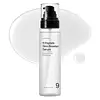What's inside
What's inside
 Key Ingredients
Key Ingredients

No key ingredients
 Benefits
Benefits

 Concerns
Concerns

No concerns
 Ingredients Side-by-side
Ingredients Side-by-side

Water
Skin ConditioningPentylene Glycol
Skin ConditioningGlycerin
Humectant1,2-Hexanediol
Skin ConditioningButylene Glycol
HumectantNiacinamide
SmoothingDiethoxyethyl Succinate
SolventAmmonium Acryloyldimethyltaurate/Vp Copolymer
Sodium PCA
HumectantAllantoin
Skin ConditioningXanthan Gum
EmulsifyingAdenosine
Skin ConditioningDisodium EDTA
Citric Acid
BufferingAcetyl Glucosamine
Skin ConditioningHyaluronic Acid
HumectantLecithin
EmollientAcetyl Glutamine
Skin ConditioningEthylhexylglycerin
Skin ConditioningCaprylyl Glycol
EmollientPolyglyceryl-10 Laurate
Skin ConditioningHexapeptide-11
Skin ConditioningBacillus/Soybean Ferment Extract
Skin ConditioningSodium Hyaluronate
HumectantOligopeptide-1
Skin ConditioningFolic Acid
Skin ConditioningOligopeptide-2
Skin ConditioningOligopeptide-3
Skin ConditioningCopper Tripeptide-1
Skin ConditioningTripeptide-1
Skin ConditioningPalmitoyl Pentapeptide-4
Skin ConditioningPalmitoyl Tripeptide-1
Skin ConditioningHexapeptide-9
Skin ConditioningWater, Pentylene Glycol, Glycerin, 1,2-Hexanediol, Butylene Glycol, Niacinamide, Diethoxyethyl Succinate, Ammonium Acryloyldimethyltaurate/Vp Copolymer, Sodium PCA, Allantoin, Xanthan Gum, Adenosine, Disodium EDTA, Citric Acid, Acetyl Glucosamine, Hyaluronic Acid, Lecithin, Acetyl Glutamine, Ethylhexylglycerin, Caprylyl Glycol, Polyglyceryl-10 Laurate, Hexapeptide-11, Bacillus/Soybean Ferment Extract, Sodium Hyaluronate, Oligopeptide-1, Folic Acid, Oligopeptide-2, Oligopeptide-3, Copper Tripeptide-1, Tripeptide-1, Palmitoyl Pentapeptide-4, Palmitoyl Tripeptide-1, Hexapeptide-9
 Reviews
Reviews

Ingredients Explained
These ingredients are found in both products.
Ingredients higher up in an ingredient list are typically present in a larger amount.
Glycerin is already naturally found in your skin. It helps moisturize and protect your skin.
A study from 2016 found glycerin to be more effective as a humectant than AHAs and hyaluronic acid.
As a humectant, it helps the skin stay hydrated by pulling moisture to your skin. The low molecular weight of glycerin allows it to pull moisture into the deeper layers of your skin.
Hydrated skin improves your skin barrier; Your skin barrier helps protect against irritants and bacteria.
Glycerin has also been found to have antimicrobial and antiviral properties. Due to these properties, glycerin is often used in wound and burn treatments.
In cosmetics, glycerin is usually derived from plants such as soybean or palm. However, it can also be sourced from animals, such as tallow or animal fat.
This ingredient is organic, colorless, odorless, and non-toxic.
Glycerin is the name for this ingredient in American English. British English uses Glycerol/Glycerine.
Learn more about GlycerinWater. It's the most common cosmetic ingredient of all. You'll usually see it at the top of ingredient lists, meaning that it makes up the largest part of the product.
So why is it so popular? Water most often acts as a solvent - this means that it helps dissolve other ingredients into the formulation.
You'll also recognize water as that liquid we all need to stay alive. If you see this, drink a glass of water. Stay hydrated!
Learn more about Water